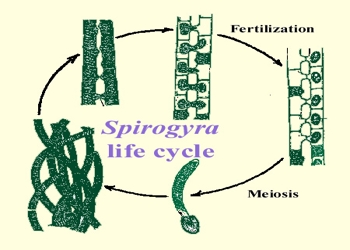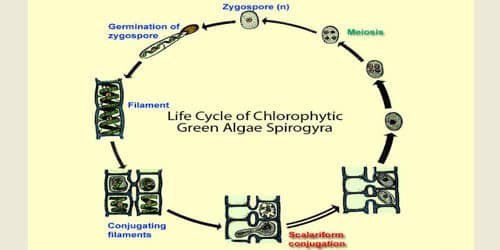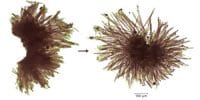When haploid (n) or gametophytic generation and diploid (2n) or sporophytic generation repeat alternately in the life cycle of any organism, it is called alternation of generation. Alternation of generations is the alternation of a sexual phase and an asexual phase in the life cycle of an organism.
Spirogyra is a cosmopolitan, freshwater, filamentous green alga, represented by about 300 species. It is commonly known as pond silk, water silk, pond scum, or mermaid’s trees because of their bright green silky appearance.
The life cycle of Spirogyra Consists of the following phases
- Gametophytic generation or haploid (n) phase, and
- Sporophytic generation or diploid (2n) phase

- Gametorthytic generation (n)
Spirogyra is a gametophytic plant. Through conjugation, lateral or scalariform, diploid (2n) zygospore is formed after the union (n+n) of gametes (male and female gametes) Gametophytic generation ends just after the formation of the zygote (2n) and sporophytic generation start.
- Sporophytic generation (2n)
Zygote (2n) is the only step of the sporophytic generation. The diploid generation ends just after the meiosis division.
Formation of a new plant from haploid spore (n)
Out of four cells formed from meioses division, only one remains active and three others have degenerated.
The life cycle of Spirogyra:
In Spirogyra, three types of the life cycle can be seen – vegetative and sexual cycles are most common. But asexual cycle occurs only occasionally.
- Vegetative cycle:
During the growing season, the vegetative filament of Spirogyra undergoes fragmentation, so that each fragment independently develops into a new filament by repeated cell division and elongation.
- Asexual cycles:
The asexual life cycle is less common and reported only in a few Spirogyra sp. Asexual cycles involve the formation of aplanospores, akinetest, zygospores.
- Sexual cycle:
In Spirogyra, the sexual reproduction involves a cycle alternation between a haploid vegetative filament and a diploid zygospore, towards the end of the growing season the Spirogyra filament produces aplanogametes in vegetative cells called gametangia.














